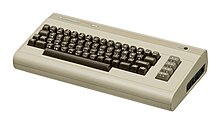
Back Commodore 64 Afrikaans Commodore 64 ALS Commodore 64 AN كومودور 64 Arabic كومودور 64 ARZ Commodore 64 Bulgarian Commodore 64 Catalan Commodore 64 Czech Commodore 64 Danish Commodore 64 German
 | |
| Manufacturer | Commodore Business Machines (CBM) |
|---|---|
| Type | Home computer |
| Release date | August 1982[1] |
| Introductory price | US$595 (equivalent to $1,880 in 2023) |
| Discontinued | April 1994 |
| Units sold | 12.5[2] – 17[3] million |
| Operating system | |
| CPU | MOS Technology 6510/8500 |
| Memory | 64 KB RAM + 20 KB ROM |
| Graphics | VIC-II (320×200, 16 colors, sprites, raster interrupt) |
| Sound | SID 6581/8580 (3× osc, 4× wave, filter, ADSR, ring) |
| Connectivity |
|
| Predecessor | |
| Successor | |
The Commodore 64, also known as the C64, is an 8-bit home computer introduced in January 1982 by Commodore International (first shown at the Consumer Electronics Show, January 7–10, 1982, in Las Vegas).[4] It has been listed in the Guinness World Records as the highest-selling single computer model of all time,[5] with independent estimates placing the number sold between 12.5 and 17 million units.[2] Volume production started in early 1982, marketing in August for US$595 (equivalent to $1,880 in 2023).[6] Preceded by the VIC-20 and Commodore PET, the C64 took its name from its 64 kilobytes (65,536 bytes) of RAM. With support for multicolor sprites and a custom chip for waveform generation, the C64 could create superior visuals and audio compared to systems without such custom hardware.
The C64 dominated the low-end computer market (except in the UK, France and Japan, lasting only about six months in Japan[7]) for most of the later years of the 1980s.[8] For a substantial period (1983–1986), the C64 had between 30% and 40% share of the US market and two million units sold per year,[9] outselling IBM PC compatibles, the Apple II, and Atari 8-bit computers. Sam Tramiel, a later Atari president and the son of Commodore's founder, said in a 1989 interview, "When I was at Commodore we were building 400,000 C64s a month for a couple of years."[10] In the UK market, the C64 faced competition from the BBC Micro, the ZX Spectrum, and later the Amstrad CPC 464.[11] but the C64 was still the second-most-popular computer in the UK after the ZX Spectrum.[12] The Commodore 64 failed to make any impact in Japan, as their market was dominated by Japanese computers, such as the NEC PC-8801, Sharp X1, Fujitsu FM-7, and MSX.[13] It also failed to sell well in France, as the Amstrad CPC 464 proved to be more successful there, with the ZX Spectrum and the Thomson MO5 and TO7 home computers also competing in the French market at the time.[14]
Part of the Commodore 64's success was its sale in regular retail stores instead of only electronics or computer hobbyist specialty stores. Commodore produced many of its parts in-house to control costs, including custom integrated circuit chips from MOS Technology. In the United States, it has been compared to the Ford Model T automobile for its role in bringing a new technology to middle-class households via creative and affordable mass-production.[15] Approximately 10,000 commercial software titles have been made for the Commodore 64, including development tools, office productivity applications, and video games.[16] C64 emulators allow anyone with a modern computer, or a compatible video game console, to run these programs today. The C64 is also credited with popularizing the computer demoscene and is still used today by some computer hobbyists.[17] In 2011, 17 years after it was taken off the market, research showed that brand recognition for the model was still at 87%.[5]
- ^ "World of Commodore Brochure" (PDF). Pcmuseum.ca. Archived from the original (PDF) on March 14, 2019. Retrieved March 18, 2017.
- ^ a b Steil, Michael (February 1, 2011). "How many Commodore 64 computers were really sold?". Pagetable.com. Archived from the original on March 6, 2016. Retrieved March 18, 2017.
- ^ Reimer, Jeremy. "Personal Computer Market Share: 1975–2004". Archived from the original on June 6, 2012. Retrieved July 17, 2009.
- ^ InfoWorld, February 1, 1982,[1].
- ^ a b "The Commodore 64, that '80s computer icon, lives again". Archived from the original on December 24, 2014. Retrieved November 17, 2014.
- ^ Cite error: The named reference
ieee85was invoked but never defined (see the help page). - ^ "The Japanese Remixes: VIC-1001 64".
- ^ "Inside the Commodore 64". PCWorld. November 4, 2008. Retrieved November 17, 2014.
- ^ Reimer, Jeremy (December 15, 2005). "Total share: 30 years of personal computer market share figures". Ars Technica. Retrieved October 10, 2014.
- ^ Naman, Mard (September 1989). "From Atari's Oval Office An Exclusive Interview With Atari President Sam Tramiel". STart. Vol. 4, no. 2. San Francisco: Antic Publishing. p. 16.
- ^ "Commodore 64 turns 30: What do today's kids make of it?". BBC News. Retrieved March 18, 2017.
- ^ Zuckerman, Faye (November 17, 1984). "Now Playing". Billboard. Vol. 96, no. 46. p. 23. ISSN 0006-2510. Retrieved June 8, 2015.
- ^ ""Giant Bomb NEC PC-8801"".
- ^ "A Discussion on the European Gaming Market in the 80s".
- ^ Kahney, Leander (September 9, 2003). "Grandiose Price for a Modest PC". CondéNet, Inc. Archived from the original on September 14, 2008. Retrieved September 13, 2008.
- ^ "Impact of the Commodore 64: A 25th Anniversary Celebration". Computer History Museum. Archived from the original on October 3, 2017. Retrieved September 13, 2008.
- ^ Swenson, Reid C. (2007). "What is a Commodore Computer? A Look at the Incredible History and Legacy of the Commodore Home Computers". OldSoftware.Com. Retrieved November 19, 2007.
© MMXXIII Rich X Search. We shall prevail. All rights reserved. Rich X Search